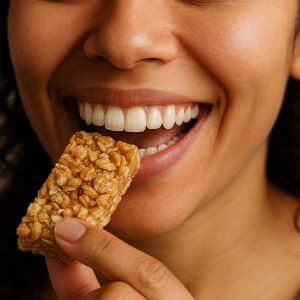 Most people are aware that candy, soda, and desserts can be rough on teeth. But sugar doesn’t just hide in obvious places. Many foods marketed as “healthy” also contain surprising amounts of added sugar, and that hidden sweetness can quietly damage dental health. Even when a product looks nutritious on the surface, the sugar inside still feeds the bacteria that cause cavities and gum disease—a fact often emphasized by an expert dentist Chicago Loop.
Most people are aware that candy, soda, and desserts can be rough on teeth. But sugar doesn’t just hide in obvious places. Many foods marketed as “healthy” also contain surprising amounts of added sugar, and that hidden sweetness can quietly damage dental health. Even when a product looks nutritious on the surface, the sugar inside still feeds the bacteria that cause cavities and gum disease—a fact often emphasized by an expert dentist Chicago Loop.
Where Sugar Hides in “Healthy” Foods
Food companies often add sugar to make items more appealing. That includes products people reach for when they want to eat better. Some common examples:
- Flavored yogurt: A single cup can pack more sugar than a candy bar, especially fruit-flavored varieties.
- Granola and protein bars: Marketed as energy boosters, many contain syrups, honey, or added sugars that add up quickly.
- Smoothies and juices: Even “all natural” versions can be loaded with sugar, whether from fruit concentrates or sweetened bases.
- Salad dressings and sauces: Bottled dressings, ketchup, and pasta sauces often rely on sugar to enhance flavor.
- Breakfast cereals: Even those labeled “whole grain” or “fortified” may contain several teaspoons of sugar per serving.
These foods don’t always taste overly sweet, which makes it easy to underestimate the sugar content. Marketing often emphasizes fiber, protein, or vitamins while downplaying the sugar content hidden in the ingredient list.
Why Sugar Matters for Teeth
The enamel protecting your teeth cannot regenerate once it’s worn away. Consuming sugar allows oral bacteria to break it down, producing acid as a harmful byproduct. That acid weakens enamel, making it easier for cavities to form. Over time, repeated exposure leads to tooth decay, sensitivity, and sometimes painful infections.
But sugar affects more than cavities. Constant exposure to hidden sugars can cause acid attacks, irritating the gums and fueling inflammation that may lead to gum disease. Once enamel is worn down, teeth become more vulnerable to staining and erosion.
The “Health Halo” Effect
One reason hidden sugar is so harmful is the “health halo” effect. When a food is labeled as organic, high-protein, or low-fat, people often assume it’s good for them across the board. That assumption makes it easier to ignore or overlook the sugar content. For example:
- A smoothie labeled “immune-boosting” may contain the equivalent of 10 teaspoons of sugar.
- A granola bar that promises “energy” may deliver most of its calories from added sweeteners rather than nutrients.
Because these foods feel like better choices than soda or candy, people may eat them more often, exposing their teeth to sugar throughout the day.
Reading Labels More Carefully
Spotting hidden sugar isn’t always easy. Food labels often list sugar under various names, including cane juice, corn syrup, agave, molasses, brown rice syrup, and concentrated fruit juice. Even honey and maple syrup, while natural, act like sugar on your teeth.
A good rule of thumb is this: if sugar or one of its many aliases shows up near the top of the ingredient list, the product likely contains more than your teeth would prefer. Nutrition labels also now separate “added sugars” from natural sugars, making it easier to see how much has been added during processing.
Smarter Choices for Dental Health
Completely avoiding sugar isn’t realistic, but a few changes can protect your teeth without forcing you to give up nutritious foods:
- Pick plain versions: Choose plain yogurt or oatmeal and add your own fruit for sweetness, rather than buying flavored versions.
- Make your own smoothies: Blending whole fruits with vegetables, protein, and little to no juice keeps sugar levels lower.
- Check portion sizes: Even a food with some sugar can be easier on teeth if eaten in moderation.
- Rinse with water: Drinking water after eating sugary foods helps wash away residue and neutralize acids.
- Snack less often: Constant grazing means constant acid exposure. Give your mouth breaks between meals.
- Don’t skip brushing: Twice-daily brushing with fluoride toothpaste and daily flossing are still the best defenses.
The Bigger Picture
Hidden sugars don’t just affect your teeth. They contribute to weight gain, diabetes risk, and energy crashes. But dental health often shows the first warning signs. Cavities and enamel erosion are clear indicators that excessive sugar intake is a problem.
By being more aware of what’s in so-called healthy foods, you can make small adjustments that protect your teeth without giving up nutrition. Choosing products with less added sugar, balancing meals with protein and fiber, and maintaining daily oral care all make a difference.
Final Thought
Healthy eating should benefit the whole body, not quietly harm your teeth. Hidden sugars make it tricky, but paying closer attention to labels and habits can help. Next time you grab a “healthy” snack or drink, remember: your mouth can tell the difference, even if the label can’t.

